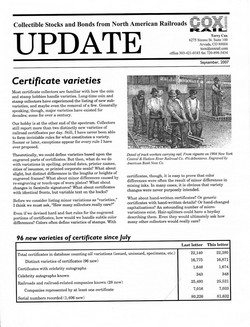
Certificate varieties
Most certificate collectors are familiar with how the coin and stamp hobbies handle varieties. Long-time coin and stamp collectors have experienced the listing of new sub-varieties, and maybe even the removal of a few. Generally speaking, though, major varieties have existed for decades; some for over a century.
Our hobby is at the other end of the spectrum. Collectors still report more than two distinctly new varieties of railroad certificates per day. Still, I have never been able to form inviolable rules for what constitutes a variety. Sooner or later, exceptions appear for every rule I have ever proposed.
Theoretically, we could define varieties based upon the engraved parts of certificates. But then, what do we do with variations in spelling, printed dates, printer names, cities of issuance, or printed corporate seals? What about slight, but distinct differences in the lengths or heights of engraved frames? What about minor differences caused by re-engraving or touch-ups of worn plates? What about changes in facsimile signatures? What about certificates with identical fronts, but variable text on the backs?
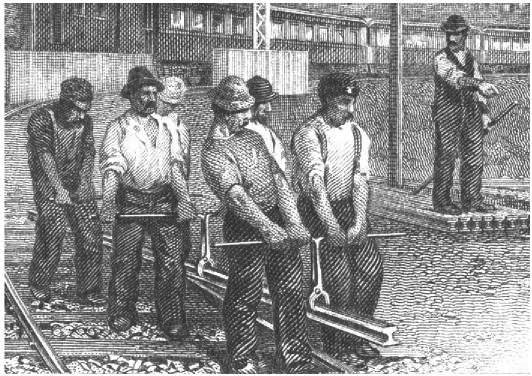 Detail of track workers carrying rail. From vignette on 1904 New York Central & Hudson River Railroad Co. 4% debentures. Engraved by American Bank Note Co.
Detail of track workers carrying rail. From vignette on 1904 New York Central & Hudson River Railroad Co. 4% debentures. Engraved by American Bank Note Co.
Before we consider listing minor variations as “varieties,” I think we must ask, “How many collectors really care?”
Even if we devised hard and fast rules for the engraved portions of certificates, how would we handle subtle color differences? Colors often define varieties of stamps. With certificates, though, it is easy to prove that color differences were often the result of minor differences in mixing inks. In many cases, it is obvious that variety changes were never purposely intended.
What about hand-written certificates? Or generic certificates with hand-written details? Or hand-changed capitalizations? An astounding number of micro-variations exist. Hair-splitters could have a heyday describing them. Even they would ultimately ask how many other collectors would really care?
Anyone who wants to catalog stocks and bonds in any specialty needs to devise fairly tight standards for what constitutes a variety. Even with tight definitions, my contributors have expanded the database to 16,871 known varieties of railroad certificates. If we cataloged every minor variation, we could easily double that number!
96 New varieties since July
|
July
letter |
This
letter |
| Number of certificates listed (counting all variants of issued, specimens, etc.) |
22,140 |
22,280 |
| Number of distinct certificates known |
16,775 |
16,871 |
| Number of certificates with celebrity autographs |
1,646 |
1,674 |
| Number of celebrity autographs known |
343 |
348 |
| Number of railroads and railroad-related companies known |
25,493 |
25,521 |
| Number of companies for which at least one certificate is known |
7,016 |
7,033 |
| Serial numbers records |
80,226 |
81,632 |
One of my correspondents calls the obsessive search for minor variations “flyspeck scripophily.” He and I agree that there is a danger in over-“varietizing” our hobby.
This leads to my #1 rule for deciding whether I should list newly-discovered features as new varieties.
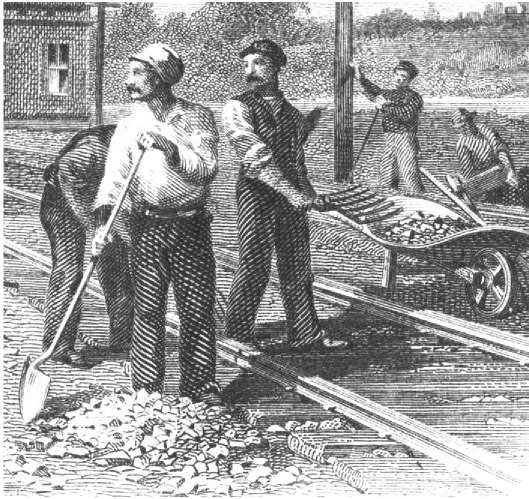 Detail of men spreading ballast from vignette on 1903 general consolidated mortgage bonds by Lehigh Valley Railroad Co. Engraved by American Bank Note Co.
Detail of men spreading ballast from vignette on 1903 general consolidated mortgage bonds by Lehigh Valley Railroad Co. Engraved by American Bank Note Co.
I try to estimate how many collectors would notice, let alone collect, possible new varieties. We can always find specialists who collect obscure features, but even they have told me they think it absurd to describe varieties that only one or two people would purposely collect.
While I argue against over-expansion of varieties, I also argue that catalogers should leave notes for the future. Prices will ultimately improve. Higher prices have always forced the search for scarcer varieties in other fields of collectibles. Even after a century, higher prices continue to force the search for increasingly obscure sub-varieties in the mature coin and stamp hobbies.
I think it necessary to keep perspective on where our hobby is and where it is going. Our hobby will probably mimic the coin and stamp hobbies. Collectors will always search for minor variations. Instead of listing minor variations with no identifiable price differentials, I generally choose to give future collectors hints on where to look for new “varieties” in the future
Reality returns to gold bond prices
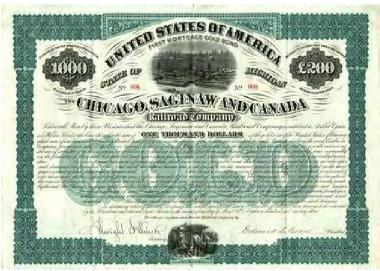
In the late 1990s, fraudulent schemes pushed prices for uncancelled gold bonds to absurd levels. Prices for rather common bonds, like the Chicago Saginaw & Canada (CS&C) shown above, rose to multi-hundred dollars. An assistant U.S. attorney-general told me that Federal investigators discovered crooks re-sold some to uninformed “investors” for as much as $10,000! The fraud promised that uncancelled gold bonds were redeemable in gold.
Prices for collectible CS&C bonds reached a high of $259 in professional auctions in Germany (2003) and $242 in the U.S. (2006).
Within the last two months, hoarded CS&C bonds have begun re-entering the market. Sales prices on eBay (US) have dropped from $164 in mid-July to $25 at the end of August. Prices for similar uncancelled gold bonds are following similar trends.
I have no idea how many more CS&C bonds may remain. My feeling is that we will see a few more sales in the $30-$50 range, before they rebound. I expect prices will ultimately even out at about $60-$75, approximately the level they were in the mid-1990s before gold bond scams disrupted prices.
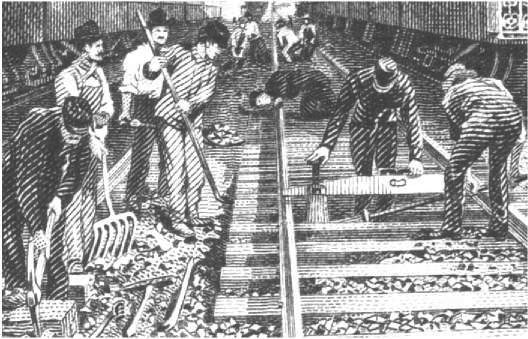 Track workers leveling and gauging rails in yard. Enlarged from vignette used on stock certificates of the Maine Central Railroad between 1912 and 1957. It seems likely this image is one called “Trains Coming and Going,” engraved by William Brown for American Bank Note Co. Image courtesy of William Knadler.
Track workers leveling and gauging rails in yard. Enlarged from vignette used on stock certificates of the Maine Central Railroad between 1912 and 1957. It seems likely this image is one called “Trains Coming and Going,” engraved by William Brown for American Bank Note Co. Image courtesy of William Knadler.
Photos and descriptions don’t agree
Some collectors get really quite irritated when pictures in auction catalogs and on eBay do not agree with the descriptions of certificates being sold. Not knowing exactly how to change things, they complain to me. They argue (and not always politely!) that it is too easy these days to show exact items being sold.
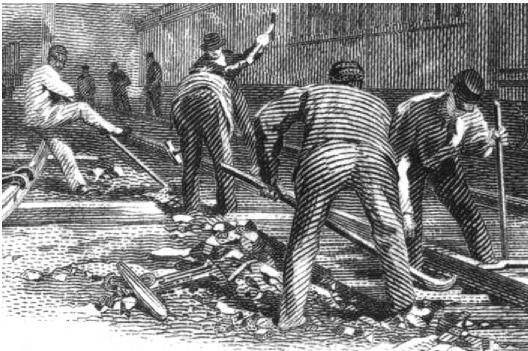 Track workers lever rail into place. Detail from vignette on 1944 general mortgage bonds by The Pittsburgh Cincinnati Chicago & St Louis Railroad Co. This image may be one titled, “Track Workers”, engraved by Robert Savage in 1898 for American Bank Note Co.
Track workers lever rail into place. Detail from vignette on 1944 general mortgage bonds by The Pittsburgh Cincinnati Chicago & St Louis Railroad Co. This image may be one titled, “Track Workers”, engraved by Robert Savage in 1898 for American Bank Note Co.
I agree that the practice is irritating. However, I often benefit from photo-description disagreements by recording two serial numbers from one listing.
In fairness, I do not think purposeful deception is intended. With many eBay sellers, I think it is simply ignorance. Beginner sellers really do not understand how important it is to hardcore certificate collectors that pictures agree with descriptions. They are not even aware of the irritation. Consequently, advanced collectors simply punish sellers with lower bids.
Some correspondents have suggested laziness. Again, I generally agree, especially if you are complaining about eBay sellers. With experienced dealers, though, there is the matter of volume. Professional dealers may have 10, 20, maybe even hundreds of certificates of the same major variety. Dealers who sell multiples, who sell at shows, and who publish fixed price lists cannot possibly use different illustrations. They have no ideas which certificates will be in stock at the time collectors contact them.
Having said that, I don’t want to make it seem as if I am giving sellers a pass. In fact, I agree with those of you who have argued that many sellers do not adequately consider how collectors buy.
It is definitely true that beginners are mostly interested in low prices. They are quite unconcerned about collecting minor sub-varieties. And they probably don’t care one bit whether pictures and descriptions agree.
However, it is equally true that buying motivations mature. With experience, collectors change their interests from pure acquisition to seeking out esoteric features such as low serial numbers, high share numbers, officer’s signatures, shareholder names, revenue stamps, company seals, and so forth.
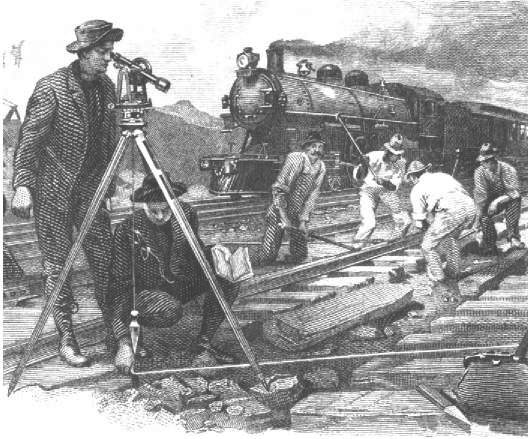 Surveying exact alignment of yard tracks. Enlarged from vignette on 1913 convertible 4.5% gold bonds of the Norfolk & Western Railway Co. Engraved by American Bank Note Co. Image courtesy David Adams.
Surveying exact alignment of yard tracks. Enlarged from vignette on 1913 convertible 4.5% gold bonds of the Norfolk & Western Railway Co. Engraved by American Bank Note Co. Image courtesy David Adams.
Those are the collectors who tell me they are put off by pictures that don’t represent the precise items being sold.
I may not be the right person to complain to, but I guess I am as good as any. Maybe I can help by listening.
My opinion is naively simplistic. In my heart of hearts, I think everyone should buy and sell certificates as if dealing with their best friends.
If true, then it should be obvious that even the very best of friends cannot always consider each other’s specific interests.
To say it another way, it might help if everyone communicated as if talking with their friends. Sellers would continually try to improve their descriptions each time they listed new items. And buyers would write, e-mail, or phone sellers when they had questions.
In my little world, I think communication is dramatically important. I think buyers can benefit when they learn more about how dealers sell certificates. And I think dealers can benefit when they understand more about how collectors collect.
In closing, let me paraphrase some points that collectors and dealers seem to want to say to each other.
Buyers: prices are absurdly low right now, but it is still your money at stake. If in doubt about any certificate being sold, please, please, please ask. But, be respectful of sellers’ time. Read descriptions carefully before asking questions.
Sellers: consider that experienced collectors are aching to discover minor varieties that mean absolutely nothing to you. Unless selling multiple certificates from one listing, make sure photos and descriptions agree.
EBay sellers: use better pictures. Good pictures of exact items being sold can save you the time of having to answer questions.
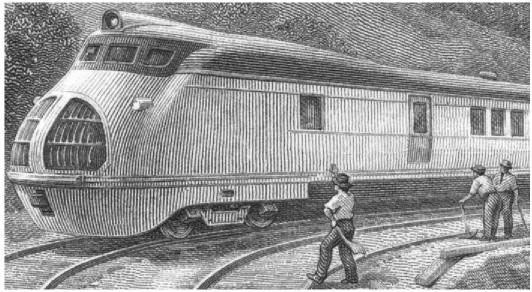 Track workers wave at Union Pacific M-10000 train. This image comes from a page of engravings in William Griffiths’ The Story of the American Bank Note Company. The all-aluminum train was built by Pullman and powered by Electro-Motive. The image probably dates from the mid-1930s while the train was touring the country. The train, however, only ran between 1934 and 1940 and this image is not known to have appeared on any Union Pacific securities.
Track workers wave at Union Pacific M-10000 train. This image comes from a page of engravings in William Griffiths’ The Story of the American Bank Note Company. The all-aluminum train was built by Pullman and powered by Electro-Motive. The image probably dates from the mid-1930s while the train was touring the country. The train, however, only ran between 1934 and 1940 and this image is not known to have appeared on any Union Pacific securities.